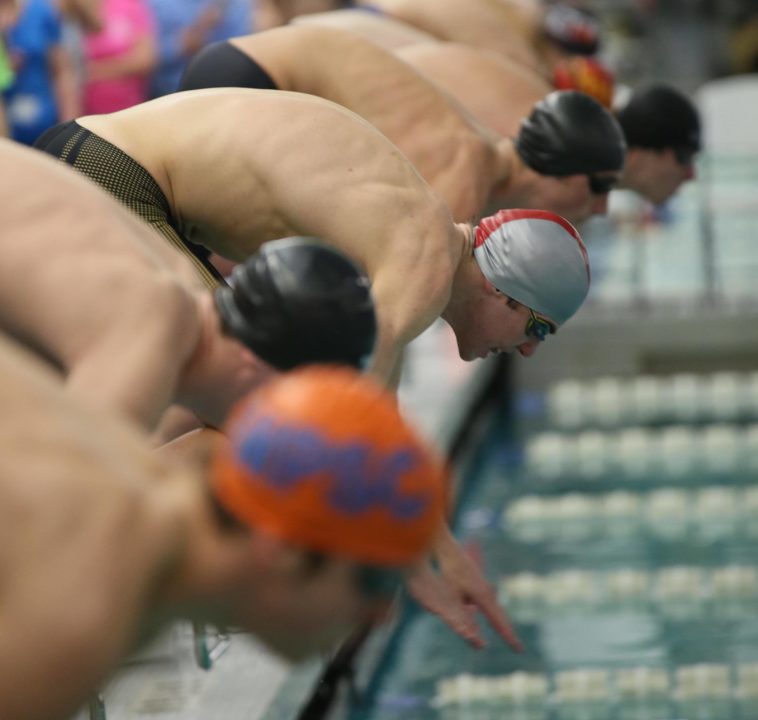Eric McGinnis is the Rollins College Strength & Conditioning Coach and Sports Performance Specialist, a former Kentucky All-American and World University Games gold medalist, and the brother of former Virginia Tech All-American Zach McGinnis. He also is a trainer at Spectrum Sports Performance. Follow him on Twitter here and on Facebook here.
We tend to get caught up in reaction times when trying to improve our starts off the block. In swimming we consider a reaction time to be the time it takes after the sound of the start for your feet to leave the block. The technical definition of a reaction time, however, would be the time it takes after the sound of the start for you to initiate movement. Actual reaction times are difficult to improve to a large degree, and there are much more important factors to consider if you’re trying to get off the blocks faster.
Rather than relating start reactions to the traditional clapping drills in which we only measure response time, we should view the ability to quickly leave the starting block as a combination of power and mechanics. These are factors that truly get an athlete “off the blocks” in a form effective enough to create swimming speed. The bottom line is that the best start is the one that allows an athlete to reach his or her breakout point the fastest, not the one performed by a swimmer who can quickly clap after hearing a whistle. The following factors are what TRULY allow a swimmer to leave the block quickly and effectively:
Factors That Affect Getting Off The Block Quickly
1. Starting Position and Mechanics
I’m not going to expand on proper start mechanics in this blog (maybe a later installment). However, as much time as we spend nit picking our swimmers’ stroke technique I’m always amazed at how little effort is applied to correcting basic start mechanics. I see kids that are painfully slow because they crouch their hips as low as possible. Raising the hips up would be an EASY fix that will instantly lead to improvement. If you really are in the dark about what an effective start should look like, watch videos of the best. I personally studied Olympic Gold medalist Roland Schoeman’s start (largely considered to be the world’s best) quite a bit while trying to perfect my own. With Youtube and social media, the resources are endless.
2. Body Weight and Dimensions
Height, weight, limb length, etc. are going to be important reaction factors (genetic marks). You can’t do anything about your height or limb length, but you CAN do something about your weight if it’s a problem. The math is simple: the bigger you are, the harder it will be to quickly move your body. Most swimmers don’t have weight problems, but this could be a limiting factor easily fixed with improved nutrition and daily routine.
3. Strength
These last two points are the most overlooked factors in building a good start. Swimmers DO need to be strong, at least strong in relationship to their body weight. We already discussed that your body weight could be too high. Conversely, your strength may be too low for your relative body weight. If moving your body weight is easy, then you will have an easier time dynamically performing the required start mechanics.
4. Rate of Force Production
Remember that we’re trying to get off the blocks QUICKLY. We don’t have all day to develop maximal force into the block. If you are strong for you body weight and you can produce force quickly then you’re going to jump high, but you need to practice doing things explosively if you’re going to improve this quality. You can’t just expect to hop on the block on race day and fly past the flags (unless you are a naturally gifted jumper). Most swimmers don’t jump well because they rarely practice jumping or other plyometric exercises outside of the pool. Having a respectable vertical jump will make you look good next to 99% of swimmers.
Common Practices That Are Overrated
1. Practicing starts off of a coach’s/teammate’s “Go”
I’m not saying this is a bad thing to do all the time, just give yourself opportunities to practice your start WITHOUT having to react. Reacting to a start is important because it’s competition specific but you should consider taking time to think about your form as well.
2. Getting into a start position and clapping your hands when you hear the beep
This is an overdone drill in my opinion. This drill is intended to train actual reaction time (although effectiveness is debatable in my opinion). If you feel like it helps you then by all means continue, but you won’t see me doing this.
3. Trying to time the starter at a meet
If a starter is either ridiculously slow or annoyingly fast then you want to be aware of that. Other than that, don’t screw yourself up by trying to time the starter. When you’re at a meet you should be on autopilot, allowing your body to do what it knows how to do best.
If there is one thing I won’t be modest about it’s my start. People have often asked me for advice on getting off the blocks better. At a body weight of 205lbs I can still squat well over twice my body weight and I have a 36-inch vertical. It’s easy to have a good start with those numbers. If you want to get real results, I advise you to seek out a strength and conditioning professional, stop standing on the side of the pool clapping your hands, and start training to become a more powerful athlete!

What machines or tools did they use to measure the reaction time?
Great article
How can I inprove my startinf of the block time?
you cant coz your bad
haha matty, good one
I’ve been trying to perfect my start lately and this helps. Good article, thanks.